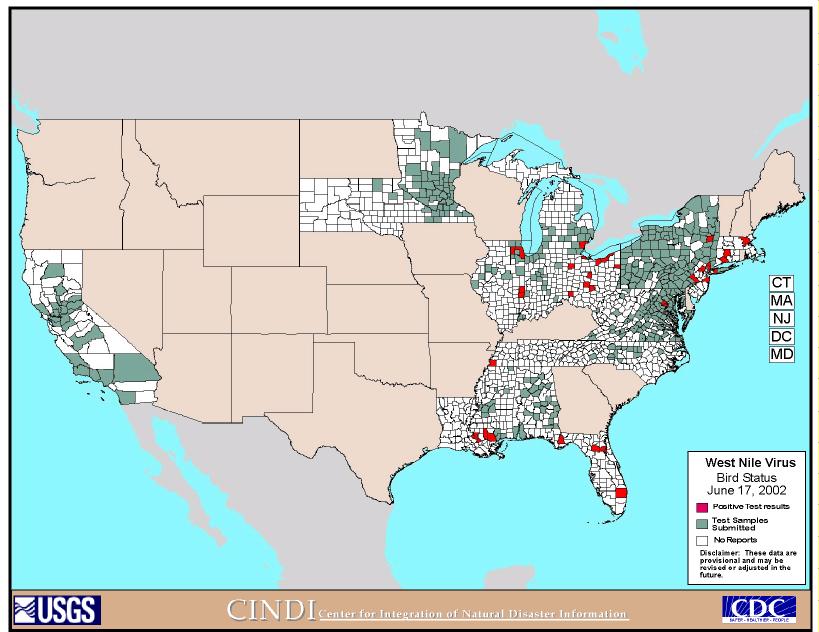| Areas of Known West Nile Virus as of 17-June-2002 |

|
Prevention and Control of West Nile Virus Infection
in Equine and Other Livestock or Poultry West Nile virus (WNV) is a vector-borne virus that was recognized in the Western Hemisphere for the first time in 1999. Invertebrate vectors, such as mosquitoes, circulate the virus among wild birds. Occasionally the virus is introduced into other vertebrate populations, such as humans or horses that serve as incidental hosts. Incidental hosts are infected animals that do not pass the virus on to vectors.
The only vectors found to be associated with the 1999 WNV outbreak in New York, New Jersey and Connecticut were mosquitoes. Several species of mosquitoes were found positive for WNV, including Culex spp., especially Culex pipiens, and Aedes vexans. No evidence has been found which suggests that any invertebrate vectors other than mosquitoes were involved in WNV transmission in 1999.
Given that mosquitoes were associated with the 1999 outbreak, the key to preventing or controlling future outbreaks of WNV among horses, livestock, or poultry is to prevent animals from being exposed to mosquitoes. The following recommendations are based on current knowledge about WNV and the 1999 U.S. outbreak. Prevention and control recommendations may be revised as new information is obtained.
Reduce Mosquito Breeding Sites
Reducing the population of mosquitoes, especially species that are undoubtedly involved with bird-to-bird transmission of WNV, such as Culex pipiens, can help to prevent or eliminate the presence of virus in a given geographical area.
The most important step any property owner can take to control mosquito populations is to remove all potential sources of stagnant water in which mosquitoes might breed. Dispose of any water-holding containers, including discarded tires. Drill holes in the bottom of containers that are left out-of-doors. Clean clogged roof gutters annually. Turn over plastic wading pools or wheelbarrows when not in use and do not allow water to stagnate in birdbaths. Aerate ornamental pools or stock them with fish. Clean and chlorinate swimming pools that are not in use and be aware that mosquitoes can breed in the water that collects on swimming pool covers. Use landscaping to eliminate standing water that collects on your property; mosquitoes can breed in any puddle that lasts more than 4 days. Thoroughly clean livestock-watering troughs monthly. Local mosquito control authorities may be able to help in assessing the mosquito breeding risks associated with a specific property.
Decrease Exposure to Adult Mosquitoes
In addition to reducing mosquito populations, preventing animals from being exposed to adult mosquitoes is important.
 Screened housing
Housing animals in structures with well-maintained insect screening can be useful to reduce exposure to adult mosquitoes. Use of such mosquito-resistant structures may actually lead to mosquito exposure unless precautions are first taken to eliminate mosquitoes from inside the structure. This may be accomplished through a number of means including the use of mosquito adulticides. In addition, use of fans may reduce potential access of mosquitoes to equine or other livestock hosts.
 Insect repellents
Use of insect repellents may be of some value in decreasing exposure of horses to adult mosquitoes. Due to practical limitations in the coverage area that may be achieved on any given horse with a particular product formulation, and due to limited duration of effectiveness of some formulations under certain conditions (e.g., perspiration), repellents should not be solely relied upon to prevent mosquito exposure. Repellents should be used according to their label instructions regarding appropriate species, method of application, and other precautions.
 Outdoor exposure
Although some species of mosquitoes feed at dusk or dawn, others are daytime feeders. As it is not yet clear which mosquitoes are responsible for the transmission of WNV to horses and other mammalian species, making recommendations as to when certain animals should avoid outdoor exposure is not particularly useful at this time. If more information becomes available, recommendations on outdoor exposure will be updated appropriately.
Vaccination
No vaccine currently exists that will prevent WNV infection in horses or other animals. Potential vaccine development is being facilitated by USDA-APHIS by making the avian and equine WNV isolates available to those with proper facilities for doing vaccine development research.
|